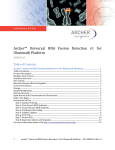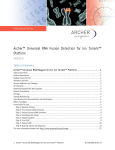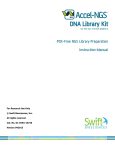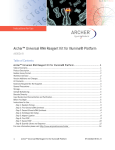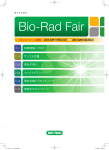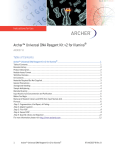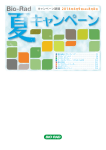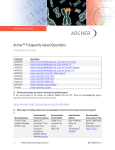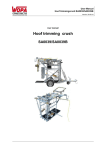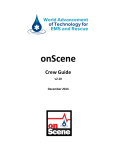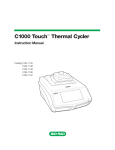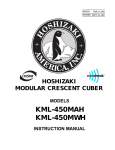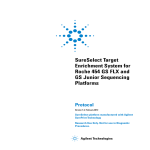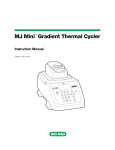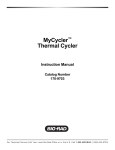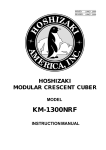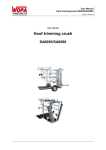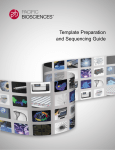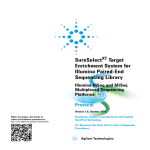Download IFU-AK0042-8 Archer Universal RNA Reagent Kit v2 for Ion Torrent
Transcript
Instructions for Use Archer™ Universal RNA Reagent Kit v2 for Ion Torrent™ Platform -8 AK0042-8 Table of Contents Table of Contents ................................................................................................................................................................... 1 Revision History ..................................................................................................................................................................... 2 Product Description ............................................................................................................................................................... 2 Modular Assay Format ........................................................................................................................................................... 2 Kit Contents ............................................................................................................................................................................ 2 Materials Required But Not Supplied .................................................................................................................................. 5 General Precautions .............................................................................................................................................................. 5 Storage and Handling............................................................................................................................................................. 5 Sample Multiplexing............................................................................................................................................................... 6 Input Nucleic Acid Concentration and Purification............................................................................................................ 6 Archer PreSeq RNA QC Assay ................................................................................................................................................ 7 Before You Begin .................................................................................................................................................................... 7 Protocol ................................................................................................................................................................................... 8 Step 1: Random Priming ........................................................................................................................................................ 8 Step 2: First Strand cDNA Synthesis .................................................................................................................................. 8 Step 3: PreSeq RNA QC Assay .............................................................................................................................................. 9 Step 4: Second Strand cDNA Synthesis ........................................................................................................................... 10 Step 5: End Repair/dA-Tailing............................................................................................................................................. 10 Step 6: Adapter Ligation...................................................................................................................................................... 12 Step 7: First PCR ................................................................................................................................................................. 13 Step 8: Second PCR ............................................................................................................................................................. 14 Step 9: Quantify Library and Sequence ............................................................................................................................. 15 For more information please visit http://www.archerdx.com...................................................................................... 16 1 Archer Universal RNA Reagent Kit v2 for Ion Torrent Platform -8 IFU-AK0042-8 Rev C Revision History From Rev To Rev B C Change Inclusion of Agencourt® AMPure® XP Bead purification in the End Repair/dA-Tailing step Altering the elution volumes related to AMPure XP Bead purification Updating workflow graphic to include Quick Start Guide Product Description Gene fusions represent an important class of genomic rearrangements in translational research. The Archer Universal RNA Reagent Kit v2 and Archer FusionPlex™ assays utilize the power of next-generation sequencing to improve the detection of genomic rearrangements over traditional methods such as immunohistochemistry (IHC) and fluorescence in situ hybridization (FISH). Modular Assay Format The Archer Universal RNA Reagent Kit v2 for Ion Torrent Platform, used in conjunction with Archer FusionPlex Assays and Molecular Barcode (MBC) Adapters, allows users to construct Ion Torrent PGM™-ready libraries from total nucleic acid or RNA samples. For Research Use Only. Not for use in diagnostic procedures. Kit Contents 1. 2. 3. 4. 2 500 mM Tris-HCl, pH 8.0 (SA0020) Ultra Pure Water (SA0021) Ultra Pure Water for Ethanol Dilution (SA0022) Reagents: a. Step 1: Random Priming (SA0001) (x2) b. Step 2: First Strand cDNA Synthesis (SA0002) (x2) c. Step 3: PreSeq RNA QC Assay-10x VCP Primer Mix (SA0121) d. Step 4: Second Strand cDNA Synthesis (SA0003) (x2) e. Step 5: End repair/dA-tailing (SA0004) f. Step 6: Adapter Ligation (SA0005) g. Step 7: First PCR (SA0111) h. Step 8: Second PCR (SA0112) Archer Universal RNA Reagent Kit v2 for Ion Torrent Platform -8 IFU-AK0042-8 Rev C 3 Archer Universal RNA Reagent Kit v2 for Ion Torrent Platform -8 IFU-AK0042-8 Rev C 4 Archer Universal RNA Reagent Kit v2 for Ion Torrent Platform -8 IFU-AK0042-8 Rev C Materials Required But Not Supplied 1. 2. 3. 4. 5. 6. 7. 8. 9. 10. 11. 12. Archer MBC Adapters for Ion Torrent Archer FusionPlex Assays or Custom Primer Panels, designed at http://assay.archerdx.com Agencourt® AMPure® XP Beads (Cat# A63881) Life Technologies™ DynaMag™ (Cat# 12331D) 100% ethanol (ACS grade) KAPA Biosystems® Library Quantification Kit – Ion Torrent™/Universal (Cat# KK4827) If nucleic acid is from FFPE tissue, it is recommended to use Agencourt FormaPure® (Cat# A33342) for extraction SYBR® qPCR Master Mix – The Archer PreSeq RNA QC Assay has been validated for the use with the following commercially available SYBR master mixes: If not using a master mix listed below, please contact technical support at [email protected] a. Recommended* 2X BioRad® iTaq™ Universal SYBR® Green Super Mix (Cat# 172-5121) b. BioRad SsoAdvanced™ Universal SYBR® Green Supermix (Cat#172-5270) c. Life Technologies™ Power SYBR® Green PCR Master Mix (Cat# 4368577) d. KAPA SYBR® FAST qPCR Kits (Cat# KK4600) e. Qiagen® QuantiTect® SYBR® Green PCR Kits (Cat# 204141) Ion Sphere Quality Control Kit (Cat# 4468656) Ion 318™ Chip Kit v2 (Cat# 4484355) Ion PGM Template OT2 200 kit (Cat# 4480974) Ion PGM Sequencing 200 kit v2 (Cat#4482006) General Precautions • • • • • • Read the entire protocol before beginning. Take note of stopping points where samples can be frozen at -20°C and plan your workflow accordingly. Use good laboratory practices to minimize cross-contamination of nucleic acid products. Always use PCR tubes, microfuge tubes and pipette tips that are certified sterile, DNase- and RNasefree. Before starting, wipe down work area and pipettes with an RNase and DNA cleaning product such as RNase Away™ (Molecular BioProducts, Inc. San Diego, CA). For consistent library amplification, ensure the thermal cycler used in this protocol is in good working order and has been calibrated to within the manufacturer’s specifications. Storage and Handling All components of the Archer Universal RNA Reagent Kit v2 (Part # AK0042-8) should be stored from 2°C to 8°C. The liquid 10x VCP, GSP1 and GSP2 primer tubes should be stored at -20 °C. Allow pouches to warm to room temperature before opening. 5 Archer Universal RNA Reagent Kit v2 for Ion Torrent Platform -8 IFU-AK0042-8 Rev C Sample Multiplexing In order to efficiently utilize the throughput of the PGM, multiple samples should be sequenced simultaneously. Samples can be identified through a unique nucleotide sequence that is part of the molecular barcode adapter ligated to the nucleic acid sequence of interest during library construction, and which is subsequently read during the sequencing process. The unique nucleotide sequence is often termed an “index”. Archer Universal RNA Reagent Kit v2 for Ion Torrent Platform utilizes a single index to distinguish between samples. The index is added during Step 6 (Adapter Ligation) and is embedded in the Ion Torrent Barcode Adapters. In order to maintain appropriate coverage depth, it is recommended that users determine the maximum number of samples that can be run on a 318 chip (assuming 5 million reads per run). In general, larger panels with more targets will require higher sequencing coverage depth, and should be run with fewer samples per chip. Below are some initial recommendations for panels of different sizes Archer Panel FusionPlex ALK, RET, ROS1 Panel v2 FusionPlex Heme Panel FusionPlex Sarcoma Panel FusionPlex NTRK Panel FusionPlex FGFR Panel FusionPlex Solid Tumor Panel FusionPlex Lung Thyroid Panel # of Targets/Assay Recommended # of Reads 29 500,000 – 1,000,000 132 134 17 17 291 41 1,000,000 – 1,500,000 1,000,000 – 1,500,000 500,000 – 1,000,000 500,000 – 1,000,000 2,000,000 – 3,000,000 1,000,000 – 1,500,000 Input Nucleic Acid Concentration and Purification • • • • • • • 6 Total nucleic acid is the preferred input for this assay. DO NOT treat the extracted total nucleic acid with DNase, as this will critically reduce the quality of RNA in the sample. If nucleic acid is from FFPE tissue, it is recommended to use Agencourt FormaPure (A33342) for extraction. We do have modifications to the published instructions: After digestion of FFPE samples at 55°C for 1 hour (step 5 of the Agencourt protocol), incubate at 80°C for 1 hour. Additionally, elute the sample in 40µL nuclease-free water at step 23. This is the minimum elution volume. When possible, it is recommended to increase the total nucleic acid input, which will increase library complexity and improve the sensitivity of the assay. If higher library complexity is desired, the assay can tolerate up to 250 ng of total nucleic acid. The minimum recommended input for the assay is 20 ng of total nucleic acid. Alternatively, 10 ng of RNA may be used. Efficient library preparation can be achieved with as little as 2 ng of total nucleic acid, provided that the starting material is of high quality and is not degraded. However, reduced input will decrease library complexity due to the restricted amount of starting unique target molecules. When using less than 10 ng of input material the PCR cycling conditions (Steps 7 and 8) may need to be altered. As the use of EDTA-containing buffers in this protocol may result in lower library yields, be sure to use buffers that do not contain EDTA (i.e. use Tris-HCl and not Tris-EDTA buffer), Archer Universal RNA Reagent Kit v2 for Ion Torrent Platform -8 IFU-AK0042-8 Rev C Archer PreSeq RNA QC Assay The Archer PreSeq RNA QC Assay is used to provide data about the integrity of amplifiable RNA in a sample, and is predictive of sequencing success. This assay measures the abundance of RNA that is of sufficient length to permit fusion calling. Laboratories should determine their own threshold for predicted sample failure based on the PreSeq RNA QC qPCR assay results. At Archer, we have found that Cq values of 30 cycles or more correspond with sequencing failure due to poor RNA integrity, while Cq values under 28.5 tend to correlate with high-quality sequencing data. 1.0 The receiver operating characteristic curve plot (ROC plot) on the left demonstrates the sensitivity and specificity of the PreSeq assay for predicting mean control start sites. For this data set of 138 FFPE samples, a Cq value of 28.589 is most predictive. 97.1 percent of samples with Cq lower than 28.589 have greater than 10 mean control start sites (sensitivity) and 83.7 percent of samples with Cq higher than 28.589 had less than 10 mean control start sites (specificity). Of the 138 samples, 47 were known to have rearrangements by FISH or RT-PCR; AMP identified all 47. 0.0 0.2 0.4 Sensitivity 0.6 0.8 28.589 (0.971, 0.837) 1.0 0.8 0.6 0.4 0.2 0.0 Specificity The PreSeq RNA QC assay is incorporated into the Archer Universal RNA Reagent Kit v2 protocol between First Strand cDNA Synthesis and Second Strand cDNA Synthesis (Steps 2 and 4 respectively). A total of 16 reactions of Random Priming, First Strand cDNA Synthesis, and Second Strand cDNA Synthesis are included with the kit to help ensure that 8 high-quality samples are identified for each batch of targeted library prep and sequencing. Before You Begin • • 7 Make fresh 10 mM Tris-HCl. o Mix 20 µL 500 mM Tris-HCl, pH 8.0 (SA0020) with 980 µL Ultra Pure Water (SA0021). Make fresh 70% ethanol. o Add 14 mL 100% ethanol (ACS grade; not included) to entire bottle containing Ultra Pure Water for Ethanol Dilution (SA0022). o Note the date on which ethanol is added; 70% ethanol is appropriate for use for one week after mixing. When not in use, tightly close the bottle cap to minimize evaporation. Archer Universal RNA Reagent Kit v2 for Ion Torrent Platform -8 IFU-AK0042-8 Rev C Protocol Step 1: Random Priming 1.1. Pre-heat thermal cycler to 65°C with a heated lid. 1.2. Gently open the Random Priming (SA0001) foil pouch by tearing along the indents located at the top of the silver package. 1.3. Remove the green 8-tube strip. Each tube in the strip provides a single reaction. 1.3.1. If you would like to use fewer than 8 reactions, carefully detach the appropriate number of tubes using clean scissors or a new razor blade. Store the remaining unused tubes at 4°C in the sealed foil pouch with the provided desiccant. 1.4. Centrifuge briefly to ensure lyophilized material is in the bottom of the tube. 1.5. Place the tubes on ice and to each add: 1.6. Ultra Pure Water (SA0021) 20 – X µL Purified Total Nucleic Acid X µL Total 20 µL After the lyophilized pellet dissolves, gently pipet up and down 6 – 8 times and briefly spin down. 1.7. Transfer the tubes from ice to the thermal cycler and incubate at 65°C for 5 minutes. 1.8. Remove tubes from thermal cycler and place on ice for 2 minutes, then briefly centrifuge before proceeding with First Strand cDNA Synthesis. Step 2: First Strand cDNA Synthesis 2.1. Gently open the First Strand cDNA Synthesis (SA0002) foil pouch by tearing along the indents located at the top of the silver package. 2.2. Remove the purple 8-tube strip. Each tube in the strip provides a single reaction. 2.2.1. If you would like to use fewer than 8 reactions, carefully detach the appropriate number of tubes carefully using clean scissors or a new razor blade. Store the remaining unused tubes at 4°C in the sealed foil pouch with the provided desiccant. 2.3. Centrifuge briefly to ensure lyophilized material is in the bottom of the tube. 2.4. Place the First Strand cDNA Synthesis tubes on ice and transfer 20 µL of the Random Priming mixture (Step 1.8.) to the lyophilized First Strand cDNA Synthesis pellet. After the lyophilized pellet dissolves, mix well by gently pipetting up and down 6 – 8 times. Spin briefly to collect contents at the bottom of the tube. 2.5. Place the tubes into a thermal cycler with a heated lid set to ≥100°C and incubate as follows: 8 Archer Universal RNA Reagent Kit v2 for Ion Torrent Platform -8 IFU-AK0042-8 Rev C Step 1 2 3 4 2.6. Incubation Temperature 25°C 42°C 80°C 4°C Incubation Time 10 min 30 min 20 min Hold Remove the PCR tubes from the thermal cycler, briefly centrifuge and place on ice. Step 3: PreSeq RNA QC Assay 3.1. Thaw 10x VCP Primer Mix (SA0121) at room temperature. 3.2. Transfer 1 µL of cDNA from First Strand cDNA synthesis to a new PCR tube containing 9 µL Ultra Pure Water (SA0021). 3.3. Briefly vortex and centrifuge diluted cDNA from Step 3.2. 3.4. For 1 Reaction setup the qPCR assay as follows: Components: 2X SYBR Green Master Mix For a 10 µL Reaction: 5 µL Diluted cDNA sample 4 µL 10X VCP Primer Mix 1 µL Total 10 µL NOTE: Master mix preparation is recommended to avoid variability due to pipetting small volumes. Create a volume of master mix comprising 2X SYBR Green Master Mix and 10X VCP Primer Mix adequate for the total number of planned reactions. Aliquot appropriate volume of master mix into each reaction tube, then add appropriate volume of diluted cDNA sample. 3.5. Place the reactions in a real-time PCR instrument and perform cycling with the following protocol: Step Activation / Denaturation Denaturation Anneal / Extension / Data acquisition Melt curve Incubation Temperature 95°C 95°C 60°C 60˚C – 95˚C Incubation Time* # of cycles 20 sec 1 3 sec 35 30 sec 0.5˚C increment or default setting *This protocol is for fast cycling conditions. If your instrument requires standard cycling conditions increase the denaturation step and anneal/extension step to 15 and 60 sec, respectively. NOTE: qPCR can be run alongside Second Strand cDNA Synthesis. Data generated can be reviewed during the stopping point after step 4.6. 9 Archer Universal RNA Reagent Kit v2 for Ion Torrent Platform -8 IFU-AK0042-8 Rev C Step 4: Second Strand cDNA Synthesis 4.1. Gently open the Second Strand cDNA Synthesis (SA0003) foil pouch by tearing along the indents located at the top of the silver package. 4.2. Remove the 4.2.1. 8-tube strip. Each tube in the strip provides a single reaction. If you would like to use fewer than 8 reactions, carefully detach the appropriate number of tubes carefully using clean scissors or a new razor blade. Store the remaining unused tubes at 4°C in the sealed foil pouch with the provided desiccant. 4.3. Centrifuge briefly to ensure lyophilized material is in the bottom of the tube. 4.4. To the Second Strand cDNA Synthesis tube on ice add: Ultra Pure Water (SA0021) First Strand cDNA Synthesis reaction (Step 2.6.) 21 µL 19 µL Total 40 µL 4.5. Allow the pellets to dissolve and then gently pipet up and down 6 – 8 times to mix. Spin briefly to collect contents at the bottom of the tube. 4.6. Incubate at 16°C for 1 hour. If a thermal cycler is used for the incubation do not use a heated lid or close the heated lid. Do not allow the temperature to rise above 16°C. Stopping point: It is OK to stop and store the library at -20°C. It is recommended to review the qPCR results from the Archer PreSeq RNA QC Assay (Step 3) at this time to determine predicted sample success. Step 5: End Repair/dA-Tailing 5.1. Gently open the End Repair/dA-Tailing (SA0004) foil pouch by tearing along the indents located at the top of the silver package. 5.2. Remove the blue 8-tube strip. Each tube in the strip provides a single reaction. 5.2.1. If you would like to use fewer than 8 reactions, carefully detach the appropriate number of tubes using clean scissors or a new razor blade. Store the remaining unused tubes at 4°C in the sealed foil pouch with the provided desiccant. 5.3. Centrifuge briefly to ensure lyophilized material is in the bottom of the tube. 5.4. Transfer 40 µL of the Second Strand cDNA Synthesis reaction (Step 4.6.) into tube containing lyophilized End Repair/dA-Tailing (SA0004) reagents. After the lyophilized pellets dissolve, mix well by gently pipetting up and down 6 – 8 times. Spin briefly to collect contents at the bottom of the tube. 5.5. Incubate the reaction in a thermal cycler with a heated lid set to ≥100°C and incubate as follows: Step 1 2 3 4 10 Incubation Temperature 12°C 37°C 72°C 4°C Incubation Time 15 min 15 min 15 min Hold Archer Universal RNA Reagent Kit v2 for Ion Torrent Platform -8 IFU-AK0042-8 Rev C 5.6. Ensure the reaction cools to 4°C and briefly centrifuge reactions before proceeding. Post-End Repair/dA Tailing AMPure XP Beads Purification 5.7. Add 100uL of AMPure beads to the 40µL reaction for a ratio of 2.5X. Make sure that the AMPure XP beads have reached room temperature and are fully resuspended by vortexing prior to adding to the sample. 5.8. Vortex well or pipette 10 times to mix and visually inspect the color of the sample to ensure a homogenous mixture. 5.9. Incubate for 5 minutes at room temperature. Place tubes on magnet for 2-4 minutes or until beads are pelleted and solution is clear. 5.10. Carefully pipette off and discard supernatant without disturbing the beads. 5.11. Without disturbing the separated beads, wash by adding 200 µL of 70% ethanol while on the magnet and incubate for 30 sec at room temperature. Carefully remove ethanol and discard. Repeat this procedure for a total of 2 washes. 5.12. After the final wash, briefly spin down and carefully remove remaining ethanol supernatant while taking care not to disturb the beads. With the caps open, dry beads at room temperature for 5 minutes. Take care not to over-dry the beads as this can reduce yield. 5.13. Remove tubes from the magnet and elute DNA by thoroughly resuspending the beads in 52 µL of Ultra Pure Water. 5.14. Place the AMPure bead solution back on magnet for 2 minutes Adapter selection and addition 5.15. Gently open a pouch of Archer MBC Adapters for Ion Torrent by tearing along the indents located at the top of the silver package. 5.16. Remove the clear 8-tube strip from the foil pouch. Each tube in the strip provides a single reaction and each tube contains a different Ion Torrent MBC Adapter. (For example, reactions 1 through 8 correspond to MBC Adapters 1 through 8). 5.16.1. CRITICAL: Upon removing the 8-tube strip from the pouch, position the tubes with the hinges to the back and use a permanent marker to label the tubes.. Track the index number added to each sample from this point forward. 5.16.2. If you would like to use fewer than 8 reactions, carefully detach the appropriate number of tubes using clean scissors or a new razor blade. Store the remaining unused tubes at 4°C in the sealed foil pouch with the provided desiccant. Be sure to track which indices were used to ensure index compatibility when used in later experiments. 5.17. Centrifuge briefly to ensure lyophilized material is in the bottom of the tube. To the Archer MBC Adapters for Ion Torrent tubes on ice add 50 µL of the purified End Repaired/dA-tailed DNA (Step 5.14.). 5.18. Allow the pellet to dissolve and then gently pipet up and down 6 – 8 times to mix. Spin briefly to collect contents at the bottom of the tube. 5.19. Immediately proceed to Step 6. 11 Archer Universal RNA Reagent Kit v2 for Ion Torrent Platform -8 IFU-AK0042-8 Rev C Step 6: Adapter Ligation 6.1. Gently open the Adapter Ligation (SA0005) foil pouch by tearing along the indents located at the top of the silver package. 6.2. Remove the red 8-tube strip. Each tube in the strip provides a single reaction. 6.2.1. If you would like to use fewer than 8 reactions, carefully detach the appropriate number of tubes using clean scissors or a new razor blade. Store the remaining unused tubes at 4°C in the sealed foil pouch with the provided desiccant. 6.3. Centrifuge briefly to ensure lyophilized material is in the bottom of the tube. 6.4. Transfer 50 µL of the End Repaired/dA tailed DNA with the annealed Ion Torrent MBC Adapters (Step 5.19.) into the tube containing Adapter Ligation mix. Allow pellet to dissolve and then gently pipet up and down 6 – 8 times to mix. Spin briefly to collect contents at the bottom of the tube. 6.5. Incubate the reaction as follows. If a thermal cycler is used either set the thermal cycler lid to “off” or leave it open during the incubation. Step 1 2 3 Incubation Temperature 16°C 22°C 4°C Incubation Time 30 min 30 min Hold Post-Ligation AMPure XP Beads Purification 6.6. Add 60 µL of AMPure XP beads to the 50 µL reaction for a ratio of 1.2X. Make sure that AMPure XP Beads have reached room temperature and are fully resuspended by vortexing prior to adding to the sample. 6.7. Vortex well or pipette 10 times to mix and visually inspect the color of the sample to ensure a homogenous mixture. 6.8. Incubate for 5 minutes at room temperature. 6.9. Place tubes on magnet for 2-4 minutes or until beads are pelleted and solution is clear. 6.10. Carefully pipette off and discard supernatant without disturbing the beads. 6.11. Without disturbing the separated beads, wash by adding 200 µL of 70% ethanol while on the magnet and incubate for 30 sec at room temperature. Carefully remove ethanol and discard. Repeat this procedure for a total of 2 washes. 6.12. After the final wash, briefly spin down and carefully remove remaining supernatant while taking care not to disturb the beads. With the caps open, dry beads at room temperature for 5 minutes. Take care not to over dry the beads as this can reduce yield. 6.13. Remove tubes from the magnet and elute DNA by thoroughly resuspending the beads in 20 µL of 10 mM Tris-HCl. 6.14. Place the AMPure bead solution back on magnet for 2 minutes. 6.15. Carefully transfer 18 µL of the purified solution to a fresh 200 µL PCR tube or proceed directly to Step 7. Be sure to avoid transferring beads to the fresh tube. 12 Archer Universal RNA Reagent Kit v2 for Ion Torrent Platform -8 IFU-AK0042-8 Rev C Stopping point: It is OK to stop and store the library at -20°C. Step 7: First PCR NOTE: The Archer Universal RNA Reagent Kits v2 do not contain gene-specific primers (GSPs) in the reaction pellet. Please use the Archer FusionPlex or custom assay GSPs. 7.1. Gently open the First PCR (SA0111) foil pouch by tearing along the indents located at the top of the silver package. 7.2. Remove the clear 8-tube strip. Each tube in the strip provides a single reaction. 7.2.1. If you would like to use fewer than 8 reactions, detach the appropriate number of tubes carefully using clean scissors or a new razor blade. Store the remaining unused tubes at 4°C in the sealed foil pouch with the provided desiccant. 7.3. Centrifuge briefly to ensure lyophilized material is in the bottom of the tube. 7.4. To the First PCR tube on ice add: Purified library DNA (Step 6.15.) Liquid GSP1 Mix 18 µL 2 µL Total 20 µL 7.5. Allow the pellet to dissolve and then pipet up and down 6 – 8 times to mix. Spin briefly to collect contents at the bottom of the tube. 7.6. Incubate the reaction as follows. Note the ramp rate between 95°C and 65°C; consult your instrument user’s manual to confirm that this setting is correct. Ensure the lid temperature tracks 5°C above the incubation temperature or set the lid to ≥100°C. Incubation Temperature Incubation Time # of cycles 95°C 3 min 1 95°C 30 sec 20* 65°C [ramp rate of 0.28°C/sec] 60 sec 72°C 3 min 1 4°C HOLD 1 *NOTE: The percent of unique molecules will be reduced when the PCR cycles are increased. The number of PCR cycles can be decreased based on user experience, quantity of input material, and specific sample types. Post-First PCR AMPure XP Beads Purification 7.7. Add 24 µL of AMPure XP beads to the 20 µL reaction for a ratio of 1.2X. Make sure that AMPure XP Beads are fully resuspended by vortexing prior to adding to the sample. 7.8. Vortex well or pipette 10 times to mix and visually inspect the color of the sample to ensure a homogenous mixture. 7.9. Incubate for 5 minutes at room temperature. 13 Archer Universal RNA Reagent Kit v2 for Ion Torrent Platform -8 IFU-AK0042-8 Rev C 7.10. Place tubes on magnet for 2-4 minutes or until beads are pelleted and solution is clear. 7.11. Carefully pipette off and discard supernatant without disturbing the beads. 7.12. Without disturbing the separated beads, wash by adding 200 µL of 70% ethanol while on the magnet and incubate for 30 sec at room temperature. Carefully remove ethanol and discard. Repeat this procedure for a total of 2 washes. 7.13. After the final wash, briefly spin down and carefully remove remaining supernatant while taking care not to disturb the beads. With caps open, dry beads at room temperature for 5 minutes. Take care not to over dry the beads as this can reduce yield. 7.14. Remove tubes from the magnet and elute DNA by thoroughly resuspending the beads in 20 µL of 10 mM Tris-HCl 7.15. Place the AMPure bead solution back on magnet for 2 minutes. 7.16. Carefully transfer 18 µL of the purified solution to a fresh 200 µL PCR tube or proceed directly to Step 8. Be sure to avoid transferring beads to the fresh tube. Stopping point: It is OK to stop and store the library at -20oC. Step 8: Second PCR NOTE: The Archer Universal RNA Reagent Kits v2 do not contain gene-specific primers (GSPs) in the reaction pellet. Please use the Archer FusionPlex or custom assay GSPs. 8.1. Gently open the Second PCR (SA0112) foil pouch by tearing along the indents located at the top of the silver package. 8.2. Remove the clear 8-tube strip from the foil pouch. Each tube in the strip provides a single reaction 8.2.1. If you would like to use fewer than 8 reactions, carefully detach the appropriate number of tubes using clean scissors or a new razor blade. Store the remaining unused tubes at 4°C in the sealed foil pouch with the provided desiccant. 8.3. Centrifuge briefly to ensure lyophilized material is in the bottom of the tube. 8.4. To the Second PCR tube on ice add: Purified library DNA (Step 7.16.) Liquid GSP2 Mix 8.5. 8.6. Total 20 µL Allow the pellet to dissolve and then pipet up and down 6 – 8 times to mix. Spin briefly to collect contents at the bottom of the tube. Incubate the reaction as follows. Note the ramp rate between 95°C and 65°C; consult your instrument user’s manual to confirm that this setting is correct. Ensure the lid temperature tracks 5°C above the incubation temperature or set the lid to ≥100°C. Incubation Temperature 14 18 µL 2 µL Incubation Time Archer Universal RNA Reagent Kit v2 for Ion Torrent Platform -8 # of cycles IFU-AK0042-8 Rev C 95°C 95°C 65°C [ramp rate of 0.28°C/sec] 72°C 4°C 3 min 30 sec 60 sec 3 min HOLD 1 20* 1 1 *NOTE: The percent of unique molecules will be reduced when the PCR cycles are increased. The number of PCR cycles can be decreased based on user experience, quantity of input material, and specific sample types. Post-Second PCR AMPure XP Beads Purification 8.7. Add 24 µL of AMPure XP beads to the 20 µL reaction for a ratio of 1.2X. Make sure that AMPure XP Beads are fully resuspended by vortexing prior to adding to the sample. 8.8. Vortex well or pipette 10 times to mix and visually inspect the color of the sample to ensure a homogenous mixture. 8.9. Incubate for 5 minutes at room temperature. 8.10. Place beads on magnet for 2-4 minutes or until beads are pelleted and solution is clear. 8.11. Carefully pipette off and discard supernatant without disturbing the beads. 8.12. Without disturbing the separated beads, wash by adding 200 µL of 70% ethanol while on the magnet and incubate for 30 sec at room temperature. Carefully remove ethanol and discard. Repeat this procedure for a total of 2 washes. 8.13. After the final wash, briefly spin down and carefully remove remaining supernatant while taking care not to disturb the beads. With caps open, dry beads at room temperature for 5 minutes. Take care not to over dry the beads as this can reduce yield. 8.14. Remove tubes from the magnet and elute DNA by thoroughly resuspending the beads in 20 µL of 10 mM Tris-HCl. 8.15. Place the AMPure bead solution back on magnet for 2 minutes. 8.16. Carefully transfer 18 µL of the purified solution to a fresh 200 µL PCR tube or proceed directly to Step 9. Be sure to avoid transferring beads to the fresh tube. Stopping point: It is OK to stop and store the library at -20 oC Step 9: Quantify Library and Sequence 9.1. 15 Use the KAPA Biosystems qPCR kit (KK4827) for Ion Torrent to quantify the concentration of each library. Assume a 250 bp fragment length. After quantification, pool the barcoded libraries at equimolar concentrations and perform template preparation following the manufacturer’s protocol. Sequence on an Ion Torrent PGM 318 chip. A generic sequencing template can be created on the Torrent Server after uploading the index tag files and this template can be used to plan the run. In order to maintain the appropriate read coverage per target it is suggested to limit the number of samples per Ion Torrent PGM 318 chip based on the coverage chart under “Sample Multiplexing” on page 5 of this manual. Archer Universal RNA Reagent Kit v2 for Ion Torrent Platform -8 IFU-AK0042-8 Rev C 9.1.1. Samples within the pool should be demultiplexed using the Torrent Server with the appropriate barcode sequence. In addition the index tag file can be downloaded from our site for convenience http://www.archerdx.com/mbc-adapters 9.2. This assay workflow leads to constructs with highly efficient ePCR amplification during PGM template preparation. In order to achieve 10-30% unenriched template-positive ISPs, library should be loaded into the ePCR at 13 pM using the Ion Torrent PGM Template OT2 200 kit. Typically Ion Torrent recommends using ~20 pM of library into ePCR. However, with our more efficient amplified constructs, loading at a lower concentration is necessary to avoid a high percentage of polyclonal ISPs. After the first chip the loading concentration may be adjusted accordingly to achieve the optimal percentage of unenriched template-positive ISPs 9.3. Upon completion of the run, the data should be analyzed using Archer Analysis at http://archerdx.com/analysis Limitations of Use For Research Use Only. Not for use in diagnostic procedures. This product was developed, manufactured, and sold for in vitro use only. The product is not suitable for administration to humans or animals. SDS sheets relevant to this product are available upon request. © 2015 ArcherDX, Inc. All rights reserved. Archer™ and Archer™ FusionPlex™ are trademarks of ArcherDX, Inc. Ion ® Torrent™, PGM™, SYBR , Life Technologies™ and DynaMag™ are registered trademarks of Thermo Fischer Scientific, Inc. ® ® ® ® Bio-Rad and iTaq™ are trademarks of Bio-Rad Laboratories, Inc. Agencourt , AMPure and FormaPure are registered ® trademarks of Agencourt Biosciences Corporation, a Beckman Coulter company. KAPA Biosystems is a registered ® trademark of KAPA Biosystems, Inc. RNase Away is a registered trademark of Molecular Bio-Products, Inc. ArcherDX, Inc. th 2477 55 Street, Suite 202 Boulder, CO 80301 303-357-9001 www.archerdx.com 16 Archer Universal RNA Reagent Kit v2 for Ion Torrent Platform -8 IFU-AK0042-8 Rev C
















